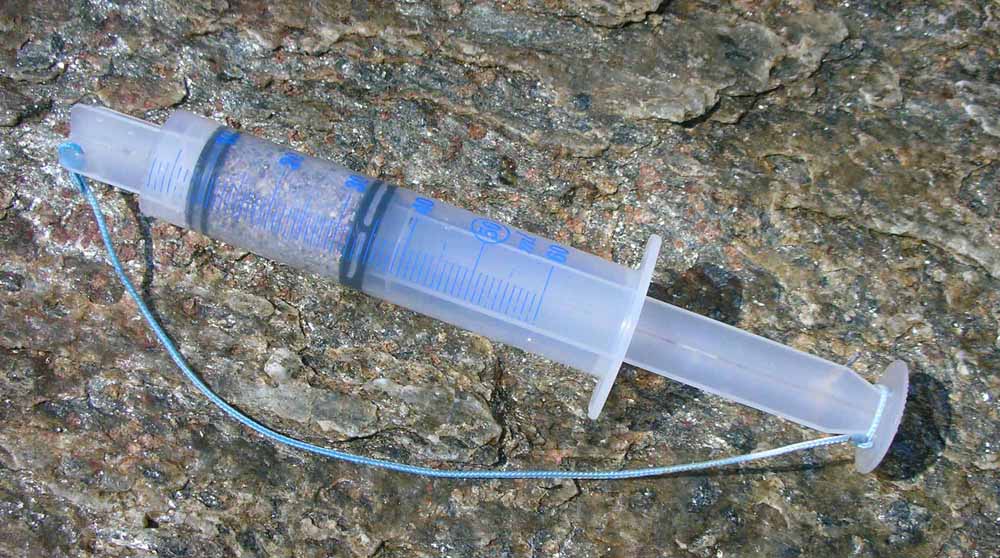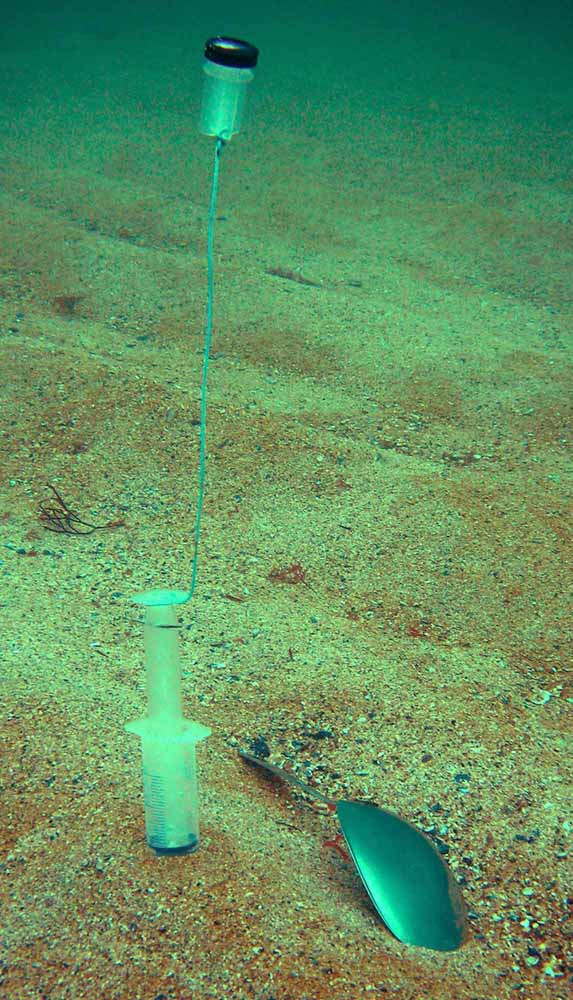Distribution of diatoms in the sand
°°°°°°°°°°°°°°
Obtaining of carrots of sand.
In
2007, during the period aout-september, 8 carrots of sand were
obtained between -5 and -14 metres (Groix island) by means of the
device illustrated below, realized with two 50 ml syringes.


Once the body
of the device was pushed about 3 cm in the sand, the spoon in
stainless steel is introduced below to allow to remove the syringe without
to disturb the carrot, after which, the small piston is introduced into
the syringe and pushed entirely in the tube.
Either immediately, or approximately 1.5 hours later (the device was
then stored vertical to the darkness), the superior 20 mm of every
carrot were split, by means of a wide blade, in 5 slices : 2 superiors
with a thickness of 3 mm, then 1 of 4 mm, and 2 of 5 mm. Every
slice was put in 10 ml of sea water. After
deep shaking, then sedimentation
of the sand, the supernatant was removed and let at rest for at least 24 hours. The obtained pellet was
stored in 1ml of 4 % of formalin in water.
Sands were dried and and the grain size distribution was determined (classification of Larsonneur, on 1977, see bibliography).
In five carrots, (among which 3 were taken in the site C; see above),
the diameter of the grains was between 0,2 and 1 mm (fine/medium sand), in
another one it was between 0,5 and 2 mm (medium/coarse sand) and in the both
last ones, it was between 0,5 and 4 mm (coarse sand).
Distribution of diatoms in the sand
In
the 8 carotts obtained in 2007, "empty" frustules (no living cell) were present in
the 15 to 20 first mm of sand.
It was always in the 3 first mm of sand that living diatoms were the most numerous and the most diverse
; their concentration decreased then more or less fast. In 2 carrots of
fine/medium sand, alive diatoms were observed only in the superior 6
mm whereas in the 3 others, they were present up to 10 mm deep. In 2 of
3 carrots of medium/coarse or coarse sand, alive diatoms were
observed up to 15-20 mm deep.
In the majority of carrots, it has not appeared a differential
distribution of the diatom species according to the depth in the sediment. The
species observed under the first 3 mm of sand were often diverse small-sized species present in the 3 first mm.
However, in the carrot of medium/coarse sand, alive diatoms present between 6 and 20 mm were essentially active
colonies of 1 to 3 tens of Bacillaria paxillifer
cells. Between 3 and 6 mm this species
also dominated, whereas it represented a lesser proportion of the
diatomic population present in the 3 first mm (approximately 8 % of the
totality of the alive species).
On an american coast, it was observed (Round,
1979, see bibliography) that the diatoms present on the surface of the sand, were
mobile species whereas, a little more deeply (between 4 and 7 mm),
lived little mobile diatoms enfeoffed in grains of sand
(strictly epipsammic species).
Other works (reported by Riaux-Gobin, 1997, see bibliography) indicate
that small and mobile species occupy the surface of the sediment (mud), whereas
bigger and more little mobile species, but also, adapted to the anoxia
and to the weak illumination (capacity in the
heterotrophy), are present some mm more deeply.
These studies concerned sediments of the littoral
zone. Our first observations concerning sub-littoral sands do not
suggest such micro distributions. The observed presence of
Bacillaria paxillifer in the depth of the sediment suggests that this
euryhaline species could have a capacity in the
heterotrophy, although we cannot exclude that the mobility
of its colonies allows it to make relatively brief raids
in the depth of the sediment.
The
study of the micro distribution of diatoms in sandy sediments is made complex by the fact that several factors
interfere. Let us quote among others the composition of the diatomic population which undergoes temporal variations, the
granulometry, the compaction and the mineralogical composition
of the sand, as well as its content in organic matter.
Besides, the fact that alive diatoms were observed between 15
and 20 mm deep in carrots of medium/coarse or coarse sand, the
porosity of which facilitates the circulation of the water,
asks the question of a possible artefactual displacement of the diatoms after obtaining of carrots.

